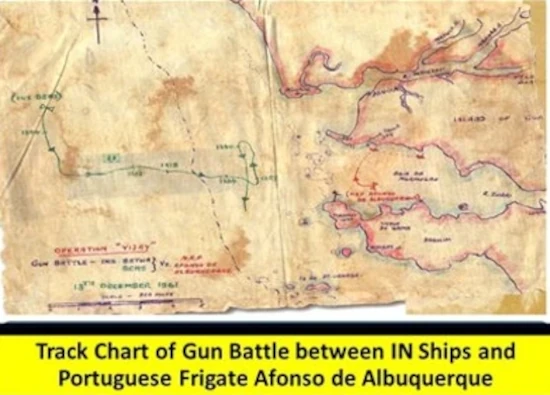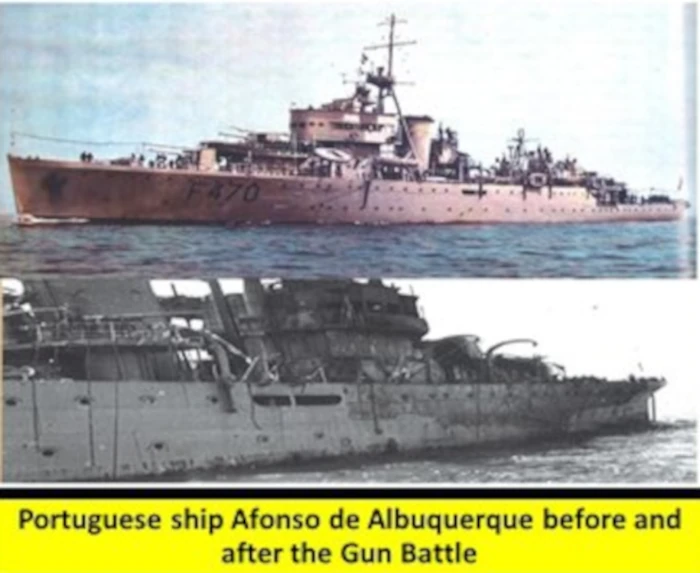Portuguese rule ended in Goa after 451 years in a war that resulted in the death of 22 Indians and 30 Portuguese.
The Portuguese military consisting of 12,000 troops in 1954 was reduced to just 3,995 in 1960. The coloniser also had 1,400 police, including 810 Indo-Portuguese who were used mainly to target those considered extremists by State Secretary Costa Gomes. The Navy consisted of the Portuguese frigate Afonso de Albuquerque with 4X 120 mm guns and three patrol boats armed with 20mm cannon called Lanchas de Fiscalização with less than 300 tons displacement – Antares, Sirius, and Vega. The air wing included a Douglas DC-4 Skymaster aircraft of the Portuguese India Airlines and a Lockheed Constellation of the Portuguese international airline (TAP).
TAP chartered plane was used to evacuate Portuguese civilians and had flown in a few air defence guns declared as ‘soccer’ equipment for defending Goa in ‘four defence’ sectors known as ‘Plano Sentinela’. The Indian Navy deployed battle ships INS Rajput, INS Kirpan, INS Mysore, INS Trishul, INS Betwa, INS Beas and INS Cauvery, INS Kuthar, INS Kirpan and aircraft carrier INS Vikrant. Support ships included minesweepers INS Karwar, Kakinada, INS Cannanore and INS Bimlipatam and Depot ship INS Dharini. INS Dharini became the Flagship of the Naval Officer In Charge Goa- Commodore Agate.
The INS Trishul with 4.5-inch guns, a gunnery squad trained at INS Venduruthy for landing under Lt SD(Gunnery) Kelman and the INS Mysore’s with 6, 4 inches and Bofors cannons were tasked with storming Anjidiv Island. With a Gunnery landing party, the author saw the landings from INS Mysore and oversaw the lowering of the whaler boat and motor cutter. The Army moved into Goa after D-Day on the 16th of December, as the Indian Air Force (IAF) launched rocket and cannon attacks on the radio station at Bambolim and the Dabolim airstrip, with orders not to damage churches or civilians or civilian sites.
With sharpshooters, the first two boats from INS Mysore and one from INS Trishul chugged towards Anjadiv island with armed landing crews, communication devices, supplies, and a National Flag. Large white flags were flown by the Portuguese. The INS Mysore, which was in contact with the boats through VHF, assumed that the landing would be unopposed. Massive ‘rat-a-tat-tat gun fire’ opened up from the island’s bushes and the Church on the hill just as the first wave of officers and sailors were heading onto the beach and the second boat was being beached, killing a few officers and sailors in the water. Others fought it out crouched across the shore in the undergrowth.
Rear Admiral B. S. Soman, Flag Officer of the Indian Fleet, looked on in wonder. The medical landing parties were rushed in boats from the nearby INS Mysore and Trishul. Undercover of Bofors guns and odd 4-inch shells from INS Mysore and INS Trishul, a second landing group assaulted the island to fight the Portuguese and take the position for the night. After meticulous shelling, the Portuguese defenses were overwhelmed the next day, and the survivors were taken as POWs.
After the island was seized at 14:00, Cdr Colaco embarked Supply Officer Cdr PS Neogi and this writer to hoist the Indian Tricolour. Two Indian Navy officials and five sailors were killed, while 19 others were injured. The POWs and civilians were kept on board the INS Mysore, where they were read the Geneva Conventions. Anglo Indian S.D. Officer Lt Kelman was injured and afterwards decorated. Onboard, there was a lot of debate.
INS Betwa cripples Afonso de Albuquerque on the 18th of December
After Bambolim was destroyed in airstrikes, the Portuguese ship Afonso de Albuquerque was moored off the coast of Mormugo to provide fire support and HF radio connections with Lisbon, with three patrol boats at Goa, Daman, and Diu. Three Indian frigates, led by the INS Betwa and commanded by Cdr Rustom Khushro Shapur ‘Rusi’ Ghandhi, arrived off the coast of the harbour at 09:00, ready to attack NRP Afonso and secure the port. Indian planes struck Mormugo harbour around 11:00 a.m. At midnight, the INS Betwa and INS Beas arrived in Goa harbour and fired salvos at the NRP Afonso their FPS Analog computer-controlled 4.5-inch cannons while sending out Morse code surrender demands.
With limited manoeuvrability in the harbour and a slow rate of fire of four 120 mm guns, only a few rounds per minute, compared to the 60 rounds per minute of the Navy’s new frigates, Afonso lifted anchor and returned the fire with 120 mm cannons.
The Afonso was hit on its bridge at 1215, injuring one of its weapons officers. A shrapnel shell detonated over the ship at 12:25, killing the ship’s radio officer and seriously injuring Captain António da Cunha Arago. The ship’s propulsion was destroyed when First Officer Pinto da Cruz took charge. She turned 180 degrees and ran aground on the Bambolim beach at 12:35. A white flag was hoisted by the Signals Sergeant against the Captain’s instructions. However, the flag coiled itself around the mast and was not noticed by INS Betwa, which continued the barrage. Many regard this as a Nelsonic deed by flamboyant gunnery specialist afterwards VADM Russi Ghandhi, who served as Lord Mountbatten’s ADC and was trained in the United Kingdom. (The suggestion was laughed down by the Admiral, the author’s neighbour in Bombay.)
After firing 400 rounds and still under fire, the Afonso Captain gave orders for the non-essential crew to ‘abandon ship,’ and the rest of the crew, including their injured Captain, evacuated onto the beach at 13:10.

Captain Arago was rushed to Panaji’s hospital. In action, NRP Afonso lost five men, and 13 were wounded. On the 19th of December, 1961, at 20:30 hrs., the frigate’s crew formally surrendered with the surviving Portuguese. Captains of the INS Betwa and INS Beas paid Captain Arago a visit when he was recuperating in Panaji. The Navy was given access to the NRP Afonso, and the Israeli Defense Forces paid a visit to the ship.
The Afonso was renamed Sarasvati by the Navy personnel and remained afloat near Dona Paula until 1962, when she was taken to Bombay and scrapped. Parts of the ship have been salvaged and are on display at Mumbai’s Naval Museum. The world-class Lisboa Maritime Museum beautifully depicts the entire story.
At the request of the Prime Minister, Portugal is sponsoring India’s Maritime Museum at Lothal, and Op Vijay, with Ops instructions, is on exhibit at the IMF Maritime Museum in C443 Defence Colony, New Delhi.
Adlai Stevenson’s United Nations Security Council (UNSC) response criticised India’s military action and requested that Indian forces leave unconditionally from Goan soil. Over President Kennedy’s protests, the US Senate Foreign Relations Committee attempted to decrease India’s foreign aid by 25% in 1962. President Kennedy informed the Indian envoy, in response to Western perceptions that India had previously lectured the world on the principles of nonviolence, “You’ve spent the last fifteen years preaching morality to us, and now you’re doing as any other country would. People are claiming that the preacher was caught exiting the brothel.”

A UNSC resolution denouncing India’s invasion of Goa was vetoed by the Soviet Union. While visiting India at the time, Soviet President Leonid Brezhnev praised the Indian move, advising Indians to disregard Western outrage because it came “from those who are accustomed to suffocating the peoples struggling for freedom and from those who enrich themselves from imperialist loot.” Nikita Khrushchev telegraphed Nehru that “Friendly India” had received “unanimous approval” from Soviet citizens. The friendship between India and the Soviet Union had begun.
FOCIF Soman embarked on his barge from INS Mysore on the 19th, knowing a surrender was taking place ashore, and the author escorted him to dock at a pier in Marmagoa as Acting Flag Lt while Lt Madan Saxena had gone to get married. The JCO drew his rifle and yelled, “It’s all right. Kahan kahan kahan kahan kahan kahan kahan kahan Bole code.” (Who Goes Where is a game – Code of Shouting). For the 20th, we had the Code. Even after I told JCO that Anjadiv had been captured and the Admiral needed to go ashore, he insisted on the code word, or he had orders to shoot. “It says Navy will be authorised only after D-Plus 3,” he remarked, referring to his list. The Admiral decided to land the following day.
In a tailpiece, Admiral Ram Das Katari writes that the Chief of General Staff, Lt. Gen. B.N. Kaul marched into Goa, leading the triumphant Indian troops, prompting Lt. Gen. J.N. Chaudhuri to query in Delhi if Army Chief Gen. K. S. Thimayya did not trust him. Katari also discusses the Chiefs’ tense relationship with V.K Krishna Menon, as well as how Gen Timmy Thimmaya was forced to quit.
In hindsight, Gen Kaul’s family was close to Nehru’s, and perhaps seeds were planted, and Kaul groomed to become the ill-fated 4 Corps Commander in the 1962 Indo-China war, as Nehru was excited by the rapid Goa operation to order the Army – TO THROW THE CHINESE OUT.

a very interesting read indeed.
thanks.